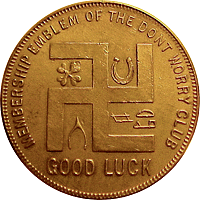If you have a question, I am glad to help the best I can and I usually respond quickly. My contact email is SageVenture@yahoo.com.
Token Value
Many of the swastika tokens are very common and are not worth more than $20 to $30 in uncirculated condition; in used condition their worth is between $5 and $15. Of course there are exceptions but for the most part, I recommend that you are careful with your bidding on places like eBay. (The "Value" link-tab to the right is for "Good Value Club"; not for token value.)
Swastika
 A great many good luck tokens were made from 1907 to 1936. Until World War II, the swastika was one of the significant symbols of good luck and was used on many tokens during this period. Of course, the German use of the swastika changed that and it is no longer used as a positive symbol. The swastika was also used in scouting and I have written about that here - sageventure.com/swastikas2.html.
A great many good luck tokens were made from 1907 to 1936. Until World War II, the swastika was one of the significant symbols of good luck and was used on many tokens during this period. Of course, the German use of the swastika changed that and it is no longer used as a positive symbol. The swastika was also used in scouting and I have written about that here - sageventure.com/swastikas2.html.
Within the swastika, there are four symbols. The first three are easy; horseshoe, four-leaf clover and wishbone. It is the fourth set of three symbols that exist on most of these tokens that seems to be unclear. I used to believe that the symbols were runic characters but after being contacted by David Ruckser who believed they were hieroglyphs, I did research in that area and now concur with David.
 Egyptian Hieroglyphs
Egyptian Hieroglyphs
For most tokens, there are three symbols but not always the same three. One is sometimes vertically inverted. I understand the hieroglyphs to be:

 (N23) Irrigation canals also used for "the two lands." (This one does not match well but it is the best match I can find at this time.)
(N23) Irrigation canals also used for "the two lands." (This one does not match well but it is the best match I can find at this time.)
 (D37) Forearm with bread loaf meaning "to give"
(D37) Forearm with bread loaf meaning "to give"
 (X1) Bread bun (or feminine) or
(X1) Bread bun (or feminine) or  (V30) ideogram for basket: master, lord.
(V30) ideogram for basket: master, lord.
Hieroglyph References:
An Egyptian coin dealer, Ala'a Farag (Al), provided me with this interpretation of the hieroglyphs: "it's the story of making food from bringing the water to the field, to agriculture, and making bread for people to feed."
Al went out of his way to be helpful so if you are interested in Egyptian coins, please visit his eBay store.
Other Thoughts on the Three Symbols
I've done my best to investigate other possibilities which includes Hobo symbols (link) and Native American symbols but noting is evident as a potential source symbol information. I actually doubt that these are Egyptian Hieroglyphs because none matched any symbols from the Egyptian magic coins (link). Hobo symbols would be very logical but I could not match up the symbols. It is interesting that this set of symbols are supposed to be good luck but I have failed to find who they are from.
Death of an Icon
An interesting article about Death of an Icon, Swastikas on Jewish tokens once common as 'Good Luck' charms by Steven H. Kaplan was written for The Shekel, volume 47, no. 1, January February 2014. The article used many of the tokens from my website for which I was acknowledged. I have made a pdf out of Death of an Icon as a reference for others.
As an attempt to classify the tokens and make it easier for viewing, I have categorized the tokens into five groups. My groups are:
An interesting variation of the swastika is that some are right facing, some left facing. It seems that the variation is primarily attributed to symmetry of design when both are used. Within the swastika arms are also good luck symbols. For the right facing swastika, the common pattern is: